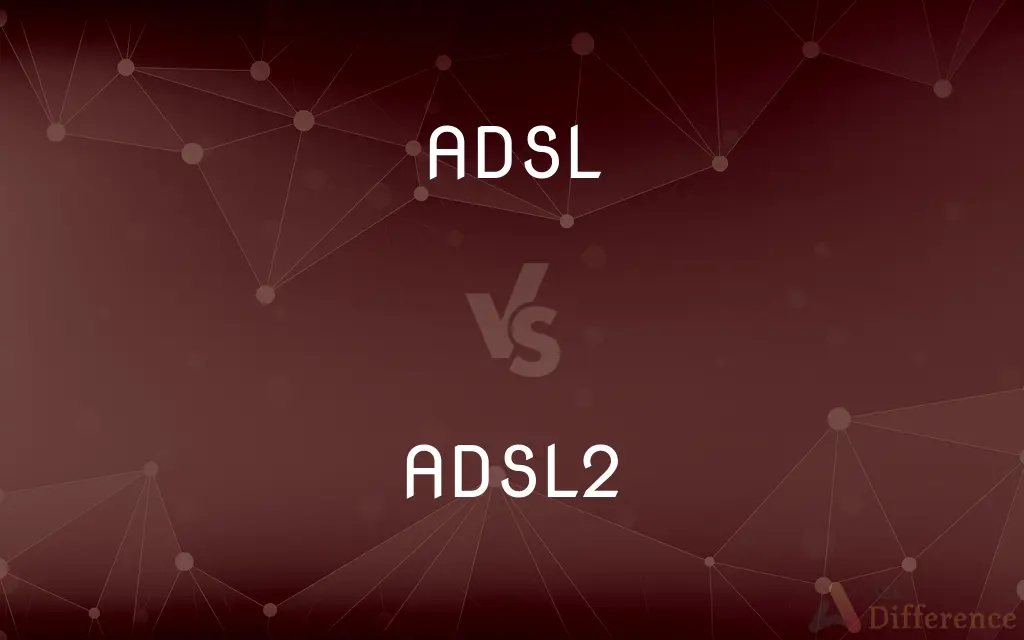ADSL vs. ADSL2 — What's the Difference?
By Tayyaba Rehman — Published on November 20, 2023
ADSL offers speeds up to 8 Mbps, while ADSL2 can reach up to 24 Mbps; ADSL2 is an improved version of the original ADSL technology.

Difference Between ADSL and ADSL2
Table of Contents
ADVERTISEMENT
Key Differences
ADSL, which stands for Asymmetric Digital Subscriber Line, is a technology that allows data transmission over standard telephone lines. On the other hand, ADSL2 is an evolution of this original technology, offering faster speeds and more reliable connections.
While ADSL can provide download speeds of up to 8 Mbps, ADSL2 pushes this limit to up to 24 Mbps, providing a noticeable boost in internet performance.
ADSL traditionally was the standard for many home internet connections. However, as users demanded more bandwidth for tasks like streaming, the ADSL2 standard was introduced.
Both ADSL and ADSL2 work on the same principle of splitting the telephone line into different frequencies for voice and data. However, ADSL2 has enhanced features and functionalities over its predecessor, ADSL.
It's crucial to note that while ADSL2 offers faster speeds, the real-world performance can vary based on factors like distance from the exchange. Both ADSL and ADSL2 have their strengths, but ADSL2 has undoubtedly set a new benchmark for broadband technology.
ADVERTISEMENT
Comparison Chart
Full Form
Asymmetric Digital Subscriber Line
Asymmetric Digital Subscriber Line 2
Maximum Speed
Up to 8 Mbps
Up to 24 Mbps
Release Date
Late 1990s
Early 2000s
Distance Sensitivity
Performance drops over longer distances
Slightly better performance over long distances
Enhanced Features
Basic broadband capabilities
Improved error correction and better performance
Compare with Definitions
ADSL
ADSL operates within a set frequency range, differentiating it from regular voice signals.
ADSL ensures that my internet browsing doesn't interfere with regular phone calls.
ADSL2
While ADSL2 offers enhanced speeds, its performance can still be influenced by the distance from the exchange.
My neighbor's ADSL2 connection isn't as fast as mine because they are located farther from the exchange.
ADSL
ADSL offers asymmetric data rates, meaning faster downloads than uploads.
With ADSL, I can download movies quickly, but uploading takes longer.
ADSL2
ADSL2 is an advanced version of the original ADSL technology, offering enhanced internet speeds.
I upgraded to ADSL2 to enjoy faster streaming and downloading.
ADSL
ADSL connections are distance-sensitive, with performance decreasing the further one is from the central exchange.
My friend's ADSL connection is slower because he lives far from the exchange.
ADSL2
ADSL2 can provide internet speeds up to 24 Mbps, a significant boost from standard ADSL.
With ADSL2, my internet experience has become smoother and more efficient.
ADSL
ADSL is a broadband technology transmitting data over standard phone lines.
My home internet connection uses ADSL, which provides a decent speed.
ADSL2
ADSL2 comes with better error correction mechanisms, ensuring a more reliable connection.
Since switching to ADSL2, I've noticed fewer connection drops and errors.
ADSL
ADSL splits the phone line into separate channels for voice and data.
Despite using ADSL for the internet, I can still make phone calls simultaneously.
ADSL2
ADSL2, like its predecessor, uses phone lines but optimizes the frequency range for better performance.
Thanks to ADSL2, I can multitask with internet activities without compromising on call quality.
Common Curiosities
What is ADSL2?
ADSL2 is an advanced version of ADSL, offering faster internet speeds and better performance.
Which is faster, ADSL or ADSL2?
ADSL2 is faster, offering speeds up to 24 Mbps compared to ADSL's 8 Mbps.
Why is ADSL called "asymmetric"?
ADSL is termed "asymmetric" because it offers faster download speeds than upload speeds.
Are ADSL and ADSL2 connections wireless?
No, both ADSL and ADSL2 use wired connections through phone lines.
Does distance from the exchange affect ADSL and ADSL2 speeds?
Yes, both ADSL and ADSL2 speeds can decrease the farther one is from the central exchange.
What does ADSL stand for?
ADSL stands for Asymmetric Digital Subscriber Line.
Do I need a special modem for ADSL2?
Yes, to utilize ADSL2 speeds, you'll need a compatible ADSL2 modem.
Can I use my phone while on an ADSL or ADSL2 connection?
Yes, both ADSL and ADSL2 allow simultaneous phone and internet usage.
Are ADSL and ADSL2 the latest broadband technologies?
While ADSL and ADSL2 are popular, there are newer technologies like VDSL and fiber-optic connections offering even faster speeds.
Can I upgrade from ADSL to ADSL2 without changing my phone line?
Yes, both ADSL and ADSL2 use the same phone lines, but you might need a new modem.
Which technology is newer, ADSL or ADSL2?
ADSL2 is the newer technology, introduced after ADSL.
Are ADSL and ADSL2 suitable for online gaming?
While both can support online gaming, ADSL2's faster speeds offer a smoother gaming experience.
Can ADSL2 modems work with ADSL connections?
Yes, most ADSL2 modems are backward compatible with ADSL connections.
What is the main advantage of upgrading from ADSL to ADSL2?
The main advantage is faster internet speeds, with ADSL2 offering up to three times the speed of ADSL.
Do ADSL and ADSL2 have the same price?
Pricing varies by provider, but ADSL2, being a superior technology, might come at a slightly higher cost than ADSL.
Share Your Discovery

Previous Comparison
Sunflower Oil vs. Groundnut Oil
Next Comparison
Cop vs. US MarshalAuthor Spotlight
Written by
Tayyaba RehmanTayyaba Rehman is a distinguished writer, currently serving as a primary contributor to askdifference.com. As a researcher in semantics and etymology, Tayyaba's passion for the complexity of languages and their distinctions has found a perfect home on the platform. Tayyaba delves into the intricacies of language, distinguishing between commonly confused words and phrases, thereby providing clarity for readers worldwide.












































